THINGS TO SEE
Overview Table
| Name | Type | |
|---|---|---|
| 1 | Old Nice | Old Town Center |
| 2 | Colline du Château | Hilltop Park |
| 3 | Menton | Old Town & Seafront |
| 4 | Èze | Village |
| 5 | Saint-Paul-de-Vence | Village |
| 6 | Bormes-les-Mimosas | Village |
| 7 | Villa Rothschild | Villa & Gardens |
| 8 | Monaco City | Old Town Center |
| 9 | Monte-Carlo | Upscale District |
Map
Click on the icon ![]() in the top-right corner to view the map in full screen.
in the top-right corner to view the map in full screen.
The best things to see are in the last layer.
Click it to display them.
Show or hide the other layers as needed.
Old Nice
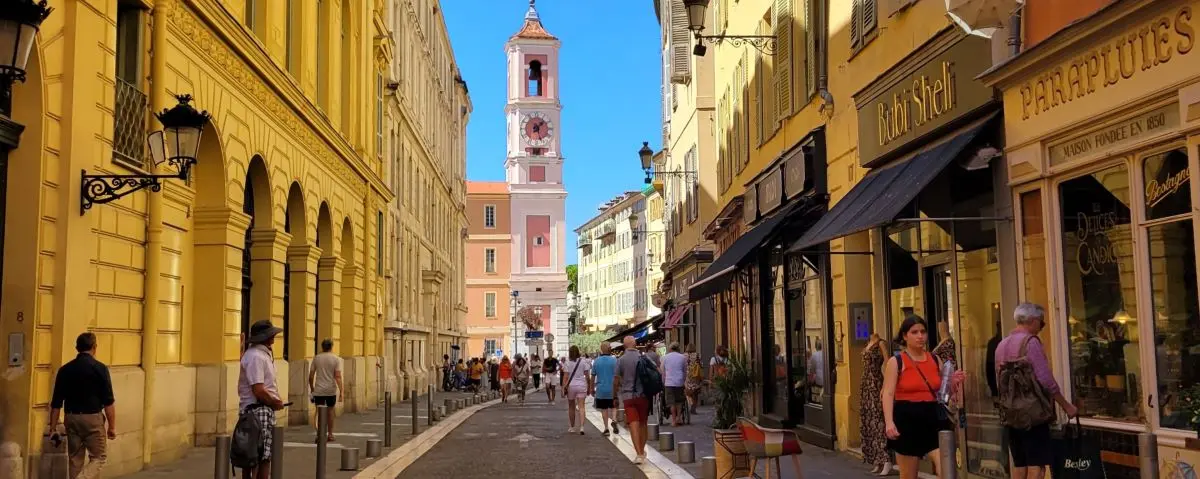
Type Old Town Center
Full Name
Vieux Nice
Old Nice, the historic heart of the city, has that one-of-a-kind Mediterranean charm where French and Italian vibes mix perfectly. You’re in this maze of narrow streets, some buzzing with life, others totally quiet. Most of the buildings date back to the 17th and 18th centuries, with super colorful architecture: think golden yellow walls, red facades, classic green shutters, and those iconic louvered blinds.
Walking through Old Nice is all about wandering with no plan, just letting your eyes catch on a carved detail, an old wooden door, or some laundry hanging out a window. The shopping streets are full of little stores where the charming and the everyday mix in this totally Southern vibe. The neighborhood changes all day long, soft light in the morning, packed and bustling at midday, then full of energy in the evening.
With its contrasts and timeless feel, Old Nice is really the soul of the city, down-to-earth and full of life. It’s a must-see if you’re looking to get a true taste of Nice.
Colline du Château

Type Hilltop Park + Panoramas
Full Name
Colline du Château
Castle Hill is the best panoramic spot in Nice. It stands 90 meters above the city, and despite the name, there’s no castle left, it was destroyed in 1706 by Louis XIV’s troops. What you’ll find instead are ruins, shady paths, pine trees offering coolness, and a man-made waterfall.
You can get up there by foot from Old Nice, or just take the free elevator. Once you’re at the top, the view hits you right away, you’ve got the perfect curve of the Bay of Angels on one side, and Port Lympia on the other. It’s one of the few places where you can take in all of Nice at once, the hills, the sea, and the red rooftops of the old town.
People come here to picnic, relax, jog in the early morning, and above all snap some great photos. Morning light here is golden and low, and by evening, it turns soft and pastel, lighting up the warm tones of the city and the deep blue of the sea.
👀 Google View 360° – Panorama West
Menton
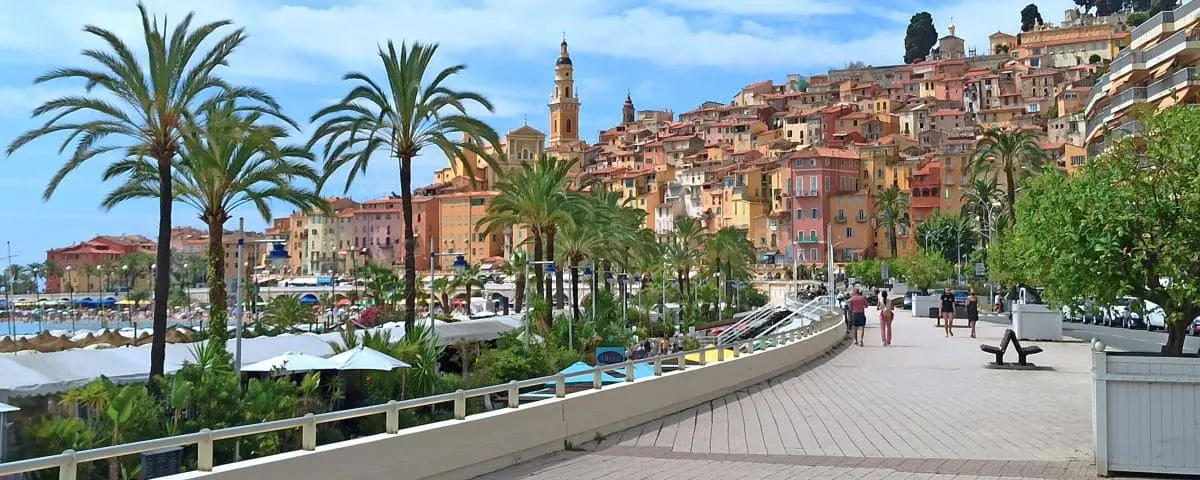
Type Old Town & Seafront
Nicknamed “the pearl of the Côte d’Azur,” Menton charms you with its lovely old-school vibe, its Italian-style colors, and a climate that’s incredibly mild. Tucked away at the far eastern edge of the French Riviera, right near the Italian border, this holiday town has managed to keep its authenticity and elegance while standing out with its own unique character.
The best way to start exploring Menton is along the seafront named Bonaparte quay. From there, you get that picture-perfect view of the old town clinging to the hillside, with its pastel façades, bell tower, and little stair-stepped alleys leading down to the water. It sets the tone right away, Menton is like something out of a postcard, calm and full of light.
You’ve absolutely got to lose yourself in the maze of old town streets. The tightly packed houses and narrow alleys create this almost meditative vibe. All paths lead up to the gorgeous square in front of the Basilica of Saint-Michel-Archange, a baroque masterpiece with a stunning facade that opens onto a stone-paved square with an incredible view. Twisting stairways, archways, and flower-filled corners make the place feel frozen in time.
Menton is also famous for its Lemon Festival, which lights up the town every February. During that time, the city gets decked out in citrus: parades, exhibitions, and giant sculptures made entirely from lemons and oranges. It’s a colorful tradition that celebrates a fruit that’s become a local symbol.
Besides its architecture and cultural life, Menton is known for its beautiful gardens and parks. These lush spaces, full of tropical plants, reflect the history of wealthy 19th-century families who came here to enjoy the sunshine. Thanks to its unique microclimate, lemon trees, orange trees, and palms thrive here all year round.
What makes Menton extra special is its laid-back lifestyle, a mix of Italian dolce vita and Provençal gentleness. You can taste dishes with a Mediterranean twist, wander through scented markets, and soak up a golden light that’s inspired painters and writers alike.
With its charming old streets, dreamy gardens, and distinct personality, Menton is one of the Côte d’Azur’s best-kept secrets, a town to savor slowly, no matter the season.
Monaco City
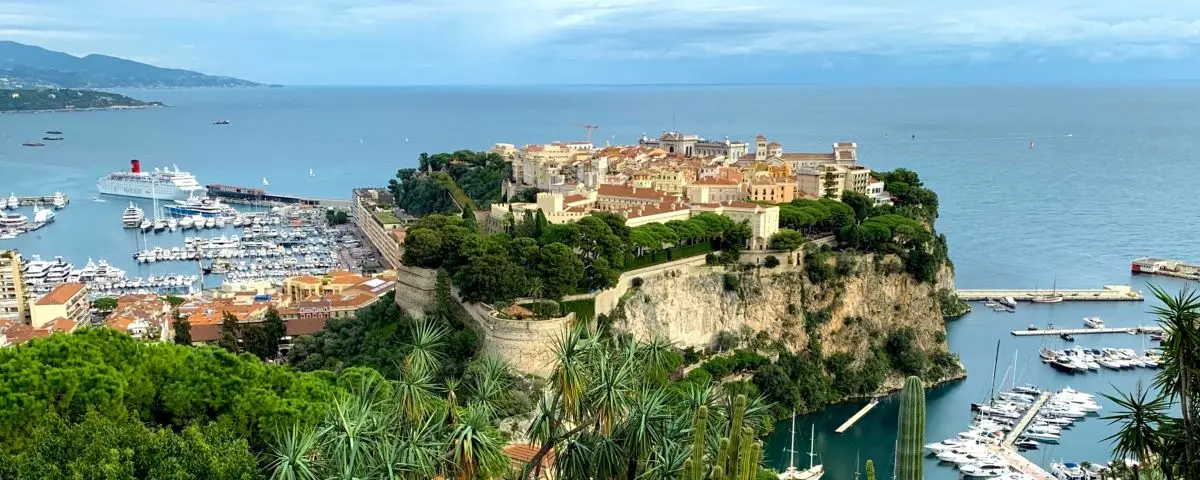
Type Old Town
Full Names
Monaco-Ville
Le Rocher
The Rock
Perched above the Mediterranean on a jaw-dropping natural cliff, Monaco-Ville, better known as “Le Rocher” or “The Rock”, is the historic heart of the principality. This is where it all began, an old town sitting on a 300-meter wide, 800-meter long spur that juts into the sea like a watchtower.
You get there from the Place d’Armes by walking up the Rampe Major, which winds through fortified gates from the 16th and 17th centuries and leads you straight to the Palace Square. At 11:55 every day, the square comes to life with the changing of the guard, a crowd-pleasing ceremony full of pomp. Surrounded by old cannonballs, the square also gives you killer views, on one side, Monte Carlo and the Italian Riviera, on the other, Fontvieille and the coast stretching toward Cap-d’Ail.
At the western tip of the Rock stands the Prince’s Palace, originally medieval. Step inside and you’re hit with a mix of grandeur and history: the Throne Room, salons filled with master paintings, the Hercules Gallery painted by the Genoese school, and the courtyard paved in black and white pebbles.
Le Rocher isn’t just about royalty, it’s also packed with culture. The Oceanographic Museum, founded by Prince Albert I, is famous for its marine collections and how the building seems to dive straight into the sea. It used to be run by Jacques Cousteau and features tanks, educational exhibits, and a façade covered in sea-themed sculptures.
Just a short walk away, the Saint-Martin Gardens give you a lush, tropical break right by the water. And not far from there, the neo-Romanesque cathedral holds the tombs of Monaco’s princes, including Rainier III and Grace Kelly.
Wandering the little streets of the Rock feels like stepping into a movie set, spotless façades, winding alleys, peaceful terraces. It’s like a live stage where Monaco’s princely history plays out, mixing elegance, detail, and just the right touch of kitsch.
Monte-Carlo (Monaco)

Type District
Full Name
Monte-Carlo
Monte Carlo is hands down the most iconic neighborhood in Monaco. It got its name back in 1866, in honor of Prince Charles III, but today it mostly brings one thing to mind: pure luxury and glam.
This is where Monaco’s social life beats the loudest. You’ve got legendary spots like the Hôtel de Paris, the Opera House, and of course, the world-famous casino. That casino, by the way, is an architectural gem in Napoléon III style, designed by Charles Garnier, the same architect who did the Paris Opera.
Monte Carlo’s also all about high-end shopping, fancy apartments, and Michelin-star dining.
And then there are the big events. In January, it kicks off with the Monte Carlo Rally. In April, it’s the Rolex Masters tennis tournament. And then comes the big one: the legendary Formula 1 Grand Prix, when the streets of Monte Carlo turn into a high-speed race track.
It’s flashy, it’s over-the-top, Monte Carlo is a place where fantasy and real life blend together without missing a beat.
Èze

Type Village
Hanging between the sky and the sea, Èze is one of the most iconic hilltop villages on the French Riviera. Clinging to the cliffside at over 400 meters above sea level, it gives you a spectacular view over the Mediterranean. It totally looks like a postcard, and yeah, it’s no hidden gem lots of people come here every year but even with the crowds, the village hasn’t lost an ounce of its charm.
As you climb up to the top, you follow these winding cobbled streets lined with beautifully restored medieval houses. You stroll around with your head in the clouds, checking out the arched passages, flower-covered façades, artisan workshops and little art galleries. Sure it’s a tourist hotspot, but the place still feels authentic.
And at the very top, the best part of the visit: the exotic garden. Set on the ruins of an old castle, this hanging haven is filled with stunning succulents, agaves and cacti from all over the world. But what’ll really blow your mind is the view a jaw-dropping panorama of the whole Riviera, from Saint-Jean-Cap-Ferrat all the way to Italy.
Èze is also perfect if you like to take your time. You’ll want to explore it early in the morning or late in the day, when there are less tourists and the streets get quiet again. With its rocky beauty, Mediterranean plants and that endless blue horizon, Èze captures that timeless Riviera vibe.
Villa Rothschild
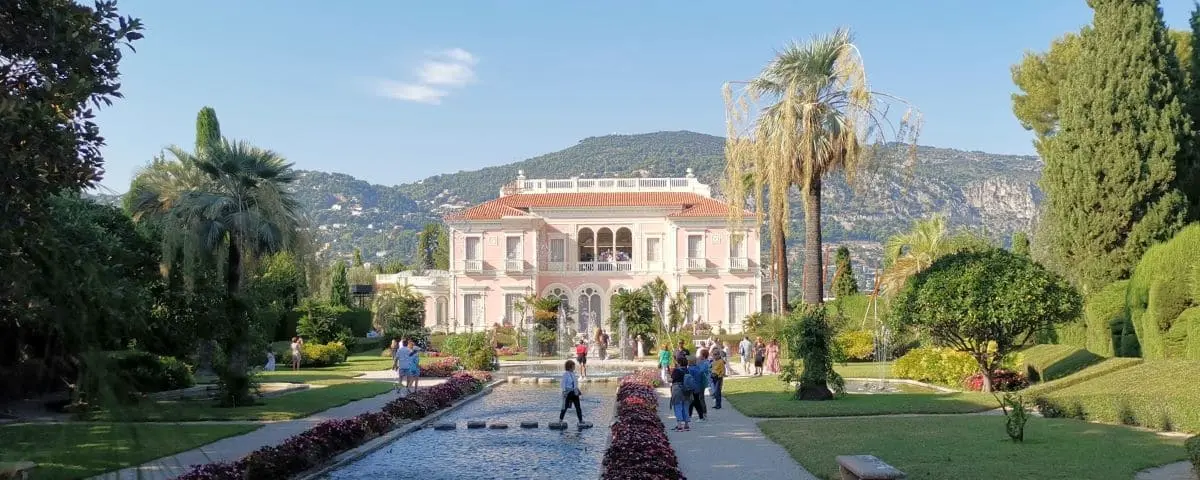
Type Villa & Gardens + Panorama
Full Name
Villa Ephrussi de Rothschild
Perched on the prestigious Cap Ferrat, the Villa Ephrussi de Rothschild is basically the wild dream of Baroness Béatrice Ephrussi, born Rothschild, come true. This stunning place, built like an Italian palace, is all about bold eclectic style, with elegance ruling every corner.
Right from the central patio, surrounded by arcades, you know you’re in for something special. Every room feels like a little jewel box, there’s a cute boudoir, Chinese salons, Louis XV furniture, and more. Everything here reflects the lavish taste and whimsical spirit of a woman obsessed with art and travel.
But the real gem is outside. The villa practically dives into the sea, with the bright blue Mediterranean wrapping around it on both sides. And the best part? It’s surrounded by nine themed gardens, some of the most impressive on the French Riviera. There’s a French garden with musical fountains, a Spanish one, Florentine, Japanese, exotic… it’s like a botanical love letter to the whole world, designed to dazzle all your senses.
Visiting this place is like stepping into early 20th-century aristocratic taste, all about luxury, eccentric flair, and jaw-dropping views over the Bay of Villefranche. It’s a must-see if you want to get a feel for the poetic extravagance of the old-school Riviera.
Saint-Paul-de-Vence
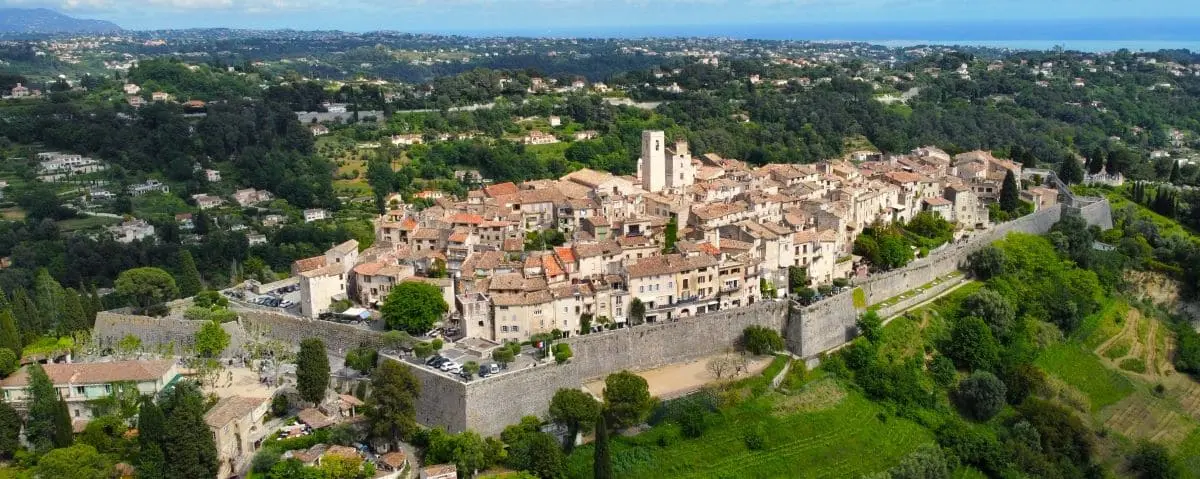
Type Village
Perched on a hill, Saint-Paul-de-Vence is a true icon of the French Riviera. For a long time it was just a quiet fortified village, but in the 20th century, it took on a whole new artistic life. Back in the 1920s and 30s, when it was still just a peaceful hamlet, painters started showing up, drawn by the region’s ever-changing light. Their canvases and brushes settled there and pretty soon, writers and movie stars followed.
Today, even with all the tourists, the magic’s still very much alive. The cobbled lanes twist and turn between perfectly restored old stone buildings. You’ve got to take your time strolling down Rue Grande, lined with noble houses from the 16th and 17th centuries, now turned into art galleries, studios and little shops. The village’s soul is still deeply artistic with around fifty galleries and studios and of course the must-see Maeght Foundation, a major spot for modern European art, just on the edge of the village.
Walking the ramparts, gives you a peaceful stroll with wide views over the surrounding countryside. There’s also the Henri-Layet path along the western wall, where you can walk in calm.
A few more things: the Folon Chapel, decorated by the Belgian artist in a dreamy mix of stained glass, mosaics and sculptures; the collegiate church, packed with paintings from the 15th to the 18th century; and the cemetery, where Marc Chagall is buried.
Bormes-les-Mimosas

Type Village
Perched on the lower slopes of the Maures mountains, Bormes-les-Mimosas really stands out as one of the prettiest villages on the French Riviera. The old medieval part has been beautifully restored and you’ll love wandering through its steep little streets full of flowers, its vaulted passages, and all those sunlit stairways and tiny squares.
It’s actually even more charming outside the busy summer season, when you can really take in the village’s amazing plant life, around 700 species from all over the world that fill the place with incredible colours and scents.
Of course, it’s the mimosa that’s put Bormes on the map. It’s been officially linked to the village since 1920 and even gave it part of its name back in 1968. In January and February, the blooming mimosa transforms the whole area and draws in nature lovers, especially for the famous Corso fleuri, a spectacular flower parade that brings thousands of people together every year.
The village also has some lovely buildings worth checking out. The 18th-century Saint-Trophyme church is really elegant with its Romanesque style and old frescoes. Not far from there, the History and Art Museum, which is set in an old mansion, shows off local paintings, sculptures and art objects. And if you head uphill, you’ll get to the ruins of the medieval castle, where the view over Cap Bénat and the Îles d’Or is just stunning.
And Bormes doesn’t stop there, it celebrates its love of flowers all year round with events like Mimosalia at the end of January and the Medieval Festival at Pentecost. These traditions, along with the amazing scenery and laid-back vibe, really make the village a must-see on the Côte d’Azur.
